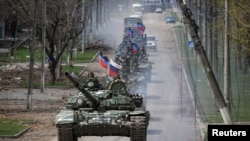ການໃຊ້ຈ່າຍທາງດ້ານທະຫານ ໄດ້ເພີ້ມສູງຂຶ້ນເປັນປະຫວັດການ ໃນປີ 2021 ທີ່ຜ່ານມານີ້ ໃນຂະນະທີ່ຣັດເຊຍຍັງເສີມຕໍ່ກະກຽມຄວາມພ້ອມທາງທະຫານຂອງຕົນ ກ່ອນການບຸກເຂົ້າໄປໃນປະເທດຢູເຄຣນ ນັ້ນຄືຄຳເວົ້າຂອງພວກນັກຄົົ້ນຄວ້າທີ່ກ່າວໃນວັນຈັນມື້ນີ້ ໂດຍທຳນາຍວ່າ ທ່າອຽງດັ່ງກ່າວ ຈະດຳເນີນຕໍ່ໄປໂດຍສະເພາະແລ້ວ ແມ່ນໃນຢູໂຣບ ອີງຕາມລາຍງານຂອງອົງການຂ່າວ AFP.
ເຖິງແມ່ນໄດ້ປະສົບກັບຄວາມເສຍຫາຍທາງດ້ານເສດຖະກິດ ຍ້ອນໂຣກລະບາດໄວຣັສໂຄໂຣນາກໍຕາມ ແຕ່ປະເທດຕ່າງໆໃນທົ່ວໂລກໄດ້ເສີມຂະຫຍາຍຄັງອາວຸດຂອງຕົນ ຊຶ່ງການໃຊ້ຈ່າຍທາງດ້ານທະຫານຂອງໂລກ ໄດ້ເພີ້ມຂຶ້ນ 0.7 ເປີເຊັນ ໃນປີກາຍນີ້ ອີງຕາມລາຍງານຂອງສະຖາບັນຄົ້ນຄວ້າສັນຕິພາບລະຫວ່າງປະເທດທີ່ນະຄອນສະຕັອກໂຮມ ທີ່ເອີ້ນຫຍໍ້ວ່າ Sipri.
ທ່ານ Diego Lopes Da Silva ເຈົ້າໜ້າທີ່ອະວຸໂສຂອງສະຖາບັນ Sipri ກ່າວຕໍ່ອົງການຂ່າວຝຣັ່ງວ່າ “ການໃຊ້ຈ່າຍທາງດ້ານທະຫານໃນປີ 2021 ໄດ້ເພີ້ມຂຶ້ນເປັນປີທີເຈັດລຽນຕິດ ຮອດ 2 ພັນ 1 ຮ້ອຍຕື້ໂດລາ. ນັ້ນແມ່ນໂຕເລກສູງສຸດ ທີ່ພວກເຮົາໄດ້ພົບເຫັນມາ.
ການໃຊ້ຈ່າຍທາງທະຫານຂອງຣັດເຊຍໄດ້ເພີ້ມຂຶ້ນ 2.9 ເປີເຊັນ ຊຶ່ງເພີ້ມຂຶ້ນເປັນປີທີສາມລຽນຕິດ ເປັນ 65.9 ຕື້ໂດລາ.
ການໃຊ້ຈ່າຍທາງດ້ານທະຫານປະກອບເປັນ 4.1 ເປີເຊັນຂອງຍອດຜະລິດຕະພັນຮວມຫຼື GDP ຂອງຣັດເຊຍ ຊຶ່ງທ່ານ Lopes Da Silva ກ່າວວ່າ “ສູງ ກວ່າອັດຕາສະເລ່ຍຂອງໂລກຫຼາຍ” ແລະເຮັດໃຫ້ຣັດເຊຍ ເປັນປະເທດທີ່ມີການໃຊ້ຈ່າຍທາງດ້ານທະຫານ ຫຼາຍເປັນອັນດັບຫ້າຂອງໂລກ.
ລາຄານ້ຳມັນແລະແກັສທຳມະຊາດທີ່ສູງຂຶ້ນ ຊ່ວຍໃຫ້ຣັດເຊຍສາມາດໃຊ້ຈ່າຍທາງດ້ານທະຫານໄດ້ຫຼາຍຂຶ້ນ. ທ່ານ Lopes Da Silva ໃຫ້ຂໍ້ສັງເກດວ່າ ການໃຊ້ຈ່າຍຂອງຣັດເຊຍໄດ້ເພີ້ມຂຶ້ນໃນຕອນໄລຍະທ້າຍປີ.
ນັກຄົ້ນຄວ້າເວົ້າວ່າ “ນັ້ນມີຂຶ້ນໃນຂະນະທີ່ຣັດເຊຍເຕົ້າໂຮມກຳລັງທະຫານຢູ່ຕາມບໍລິເວນຊາຍແດນຂອງຢູເຄຣນ ກ່ອນທີ່ຈະທຳການຮຸກຮານເຂົ້າໄປໃນປະເທດດັ່ງກ່າວເມື່ອເດືອນກຸມພາ.”
ຣັດເຊຍຈະສາມາດທຳການໃຊ້ຈ່າຍທາງທະຫານແບບຍືນຍົງໄດ້ຫຼືບໍ່ນັ້ນແມ່ນຍາກທີ່ຈະທຳນາຍໄດ້ ອີງຕາມຄຳເວົ້າຂອງທ່ານ Lopes Da Silva ຍ້ອນຄື້ນຟອງຂອງການລົງໂທດໂດຍປະເທດຕາເວັນຕົກ ເພື່ອຕອບໂຕ້ຕໍ່ການຮຸກຮານຂອງຣັດເຊຍ ເຂົ້າໄປໃນປະເທດຢູເຄຣນ.
ໃນປີ 2014 ເວລາຣັດເຊຍ ປະກາດຮວມເອົາແຫຼມໄຄຣເມຍ ເຂົ້າເປັນສ່ວນນຶ່ງຂອງດິນແດນຕົ້ນນັ້ນ ປະເທດດັງກ່າວໄດ້ຕົກເປັນເປົ້າຂອງການລົງໂທດໃນຂະນະທີ່ລາຄາພະລັງງານຕົກຕ່ຳລົງ ຈຶ່ງເປັນການຍາກທີ່ຈະຊັ່ງຊາໄດ້ວ່າ ການລົງໂທດນັ້ນມີປະສິດທິຜົນຫຼາຍປານໃດ.
Global military spending rose again in 2021, setting new records as Russia continued to beef up its military prior to its invasion of Ukraine, researchers said Monday, predicting the trend would continue in Europe in particular.
Despite the economic fallout of the global Covid pandemic, countries around the world increased their arsenals, with global military spending rising by 0.7% last year, according to a report by the Stockholm International Peace Research Institute (Sipri).
"In 2021 military spending rose for the seventh consecutive time to reach $2.1 trillion. That is the highest figure we have ever had," Diego Lopes da Silva, senior researcher at Sipri, told AFP.
Russia's spending grew by 2.9% — the third year of consecutive growth — to $65.9 billion.
Defense spending accounted for 4.1% of Russia's gross domestic product (GDP), "much higher than the world average," and making Moscow the fifth largest spender in the world, Lopes da Silva said.
High oil and gas revenues helped the country boost military expenditure. Lopes da Silva noted that Russia saw a sharp uptick in spending towards the end of the year.
"That happened as Russia amassed troops alongside the Ukrainian border preceding of course the invasion of Ukraine in February," the researcher said.
Whether Russia would be able to sustain its spending was difficult to predict, Lopes da Silva said, due to the wave of sanctions imposed by the West in response to the aggression in Ukraine.
In 2014, when Russia annexed Crimea, the country was also targeted with sanctions at the same time as energy prices fell, making it difficult to gauge how effective sanctions were on their own.
"Now... we have even tougher sanctions, that's for sure, but we have higher energy prices which can help Russia afford to maintain military spending at that level," Lopes da Silva said.
On the other side, Ukraine's military spending has risen by 72% since the annexation of Crimea. While spending declined by over 8% in 2021 to $5.9 billion, it still accounted for 3.2% of Ukraine's GDP.
As tensions have increased in Europe, more NATO countries have stepped up spending.
Eight members countries last year reached the targeted 2% of GDP for spending, one fewer than the year before but up from only two in 2014, Sipri said.
Lopes da Silva said he expected spending in Europe to continue to grow.
The U.S., which far outspent any other nation with $801 billion, actually went against the global trend and decreased its spending by 1.4% in 2021.
Over the past decade, U.S. spending on research and development has risen by 24% while arms procurement has gone down by 6.4%.
While both decreased in 2021, the drop in research was not as pronounced, highlighting the country's focus "on next-generation technologies."
"The U.S. government has repeatedly stressed the need to preserve the U.S. military's technological edge over strategic competitors," Alexandra Marksteiner, another researcher at Sipri, said in a statement.
China, the world's second largest military spender at an estimated $293 billion, boosted its expenditure by 4.7%, marking the 27th straight year of increased spending.
The country's military buildup has in turn caused its regional neighbors to beef up their military budgets, with Japan adding $7 billion, an increase of 7.3% — the highest annual increase since 1972.
Australia also spent 4% more on its military, reaching $31.8 billion in 2021.
India, the world's third largest spender at $76.6 billion, also increased funding in 2021, but by a more modest 0.9%.
The U.K. took over the number four spot, with a 3% increase in military spending to $68.4 billion, replacing Saudi Arabia which instead decreased spending by 17% to an estimated $55.6 billion.





